Since the market is currently concentrated on high-end cards and the never-ending struggle over the top-performance throne, we decided to shift our attention to a card that will not cost you an arm and a leg, ATI’s mid-range HD 4670.
ATI’s HD 4670 is comparable to Nvidia’s 9500GT GDDR3, and back when it was launched, ATI’s HD 4670 card literally buried Nvidia’s 9500GT. Today we decided to take a look at Club3D’s non-reference HD 4670 card that has a dual slot cooling solution which should make this card much less noisy, and, of course, cooler than the reference card which we tested before.
As we compared it to the 9500GT card before, today we will put it up against some more expensive cards, for example the 9600GT. Unlike all of these cards, the HD 4670 doesn’t need an additional power connector and the PCB is much shorter.

The card is based on a 55nm core, and its main advantage is low power consumption and no need for additional power, which makes the HD 4670 is a very attractive card in the upgrade and OEM markets. It is a PCIe 2.0 card that has DirectX 10.1 support, thanks to a core that’s a crippled version of RV770 architecture (HD 4800 series), UVD 2 engine and Realtek’s HD Audio 7.1 (integrated into the GPU silicone) are responsible for quality HD reproduction and processing capabilities.

Radeon HD 4670 is based on the RV730 core manufactured by TSMC in 55nm. It packs 320 stream processors, 8 ROPs and 32 texture units. We already mentioned that RV730 is a weaker and cheaper version of RV770 architecture, and although it’s cooler, it’s nowhere near as powerful. As far as Radeon HD 4670’s features go, you’ll find that they’re identical to those of much pricier HD 4800 generation. Even with filters on, you should still be able to play games at 1280x1024, and maybe even higher but with filters off, of course. Just like the rest of HD 4xxx series, this card supports CrossFireX multi-GPU technology.

Unlike the reference version of the HD 4670 which uses a single slot cooling solution, Club3D has decided to strap a dual slot cooler which has a larger fan and should have superior performance. The memory chips are cooled by a small heatsinks and the card has eight memory chips or a total 512MB of memory (64x8). Half of these modules are located on the front side while the other half ended on the back of the card.

Best of all, the card's boasts very low power consumption, which is evident from a lack of external power connector. So, PCIe slot power will be enough, as the card doesn’t draw more than 75W at full throttle.

The core of this card works at reference 750MHz, it has 320 stream processors and the 512MB of GDDR3 memory are clocked at 1,000MHz (2,000MHz effective). It’s important to note that the HD 4670 comes with a 128-bit memory bus. I/O backplate is as standard as it can be and features two DVIs and a TV-Out, while some other partners decided to go for an HDMI or DisplayPort output as well.

The card's cooler is very quiet, as some of the 120mm fans that we had in the chassis produced more noise than the cooler on the card. The cooler has automatic speed regulation depending on the temperature and it spins 38 percent when the card is idling. It spins up to 57 percent when the card reaches 55°C, and it goes to 63 percent if the card goes over 60°C. We did notice that the core sometimes goes to 61°C under full load, but the fan quickly puts it back down to 60°C. The only drawback of the cooler is that this card takes up two slots.

As you can see from the results, in idle mode, the card heats up to 42°C, which is almost the same as the reference card, but under load it's a completely different story. The card heats up to 60°C under full load, and even then the cooler remains very quiet.

The card is packed in a small black box with all the details and features listed on the back. The card is tightly wrapped in a bubble bag and the rest of the accessories can be found below in a separate compartment.

Club3D HD 4670 card has a rather modest bundle, but then again this is a mainstream card and the price tag is the main thing.

Testbed
Motherboard: DFI DK P45 T2RS (Courtesy of DFI)
Processor: Intel Core 2 Duo E8400 @ 3.0GHz
Memory: OCZ DDR2 PC2-6400 CL 3-4-4-15 FlexXLC Edition 2x1GB (Courtesy of OCZ)
Graphics card: Club3D HD 4670 512MB (Courtesy of Club3D)
Club3D HD 4850 OC Edition (Courtesy of Club3D)
MSI HD 4850 (Courtesy of MSI)
BFG 9600GT OCX ThermoIntelligence (Courtesy of BFG)
PSU: OCZ EvoStream 720W SLI (Courtesy of OCZ)
Hard drive: Seagate Barracuda 7200.9 80GB SATA (Courtesy of Seagate)
CPU Cooler: Arctic Cooling Freezer 7 Pro
Case fans : Gelid WING 12 UV Blue (Courtesy of Gelid)
Benchmarks
We must remind you that all of the test are done at maximum settings. The HD 4670 will surely give much better results at lower settings and since we are talking about a mainstream card, medium settings make a lot of sense.
Futuremark Tests
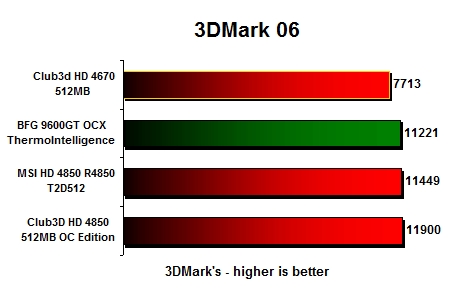
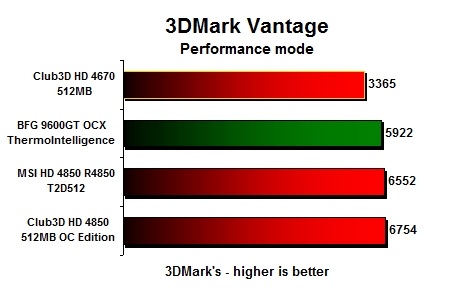
In both 3DMark 06 and 3DMark Vantage, the card shows that its higher priced competition is something that you need if you want to have good results in benchmarks. BFG’s 9600GT OCX is a card with high factory overclock and some lower clocked 9600GT cards might not be that much faster than the HD 4670. In any case, the HD 4670 gives a decent score in both Futurmark tests.
Games
The situation is similar in games, as the HD 4670 isn’t made for gaming at high resolutions with filters. It will give you a decent frame rate at lower resolutions, and once AA and AF are turned on, the framerate drops significantly.
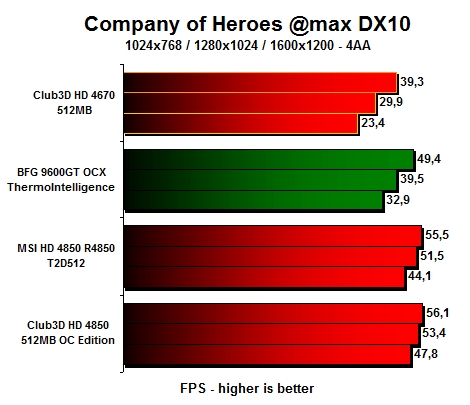
At lower settings, and lower resolutions like 1024x768 and 1280x1024, this card gives a playable frame rate in Company of Heroes. Even at maximum settings the card can give you playable framerates if you stick to lower resolutions.
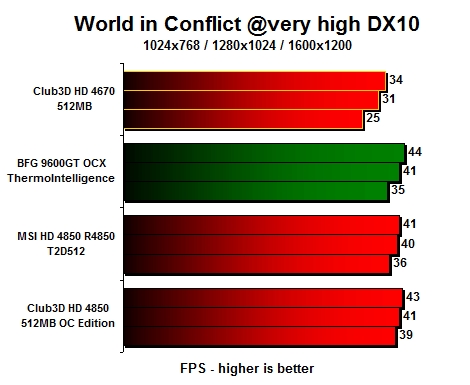
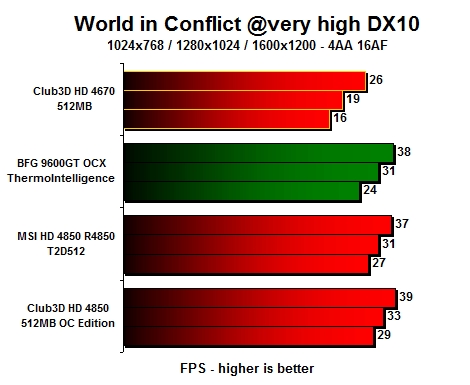
World in Conflict is a very demanding game for graphics cards, and the HD 4670 provides you with a decent framerate if you stick to lower resolutions. As you can see from the results, the framerate drops once the AA and AF are turned on, and even at 26 frames the game has very limited gameplay, but without AA and AF you can get 31 fps at 1280x1024 with maximum settings.
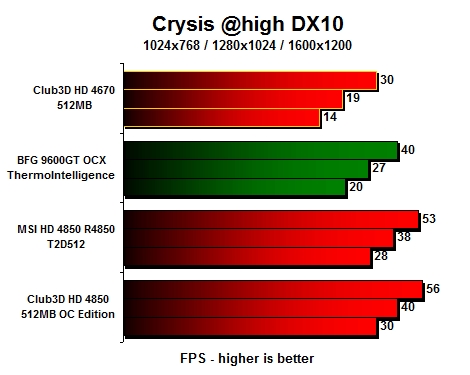
Crysis will be a benchmark game for a long time to come, as it can push the card to its edge once you set quality settings at very high. The HD 4670 can reach 30 fps at 1024x768 without filters, and it proves that it can cope with Crysis. We didn’t even bother to try it with filters, as the score would just be too low. Again, if you lower some settings and make some adjustments you can get a decent frame rate with this card.
Overclocking
We were quite surprised with its overclocking capabilities, as the card easily reached 800MHz for the GPU and 1,050 (2,100MHz) for memory. Overclocking didn't affect the cards temperature, which clearly indicates that its cooler can cope with additional heat which this card produces when overclocked.
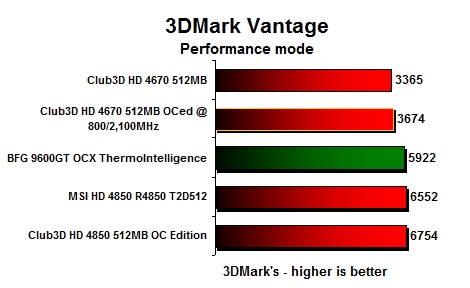
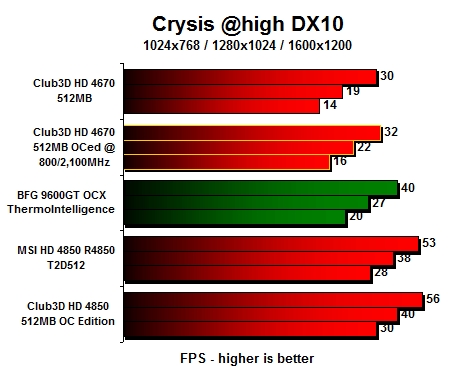
The additional 50MHz for the core and 50MHz for memory provides a decent boost to the card’s performance and it can give you an additional couple of FPS in Crysis. The 3DMark Vantage score rose for 309 points to P3674. Thanks to the effective and quiet cooler, you won't have to cope with much more noise as a result of your oveclocking efforts.

Conclusion
Club3D has three versions of the HD 4670 card, one with 1GB of memory, and two with 512MB of GDDR3 memory. The one that we tested works at 1,000MHz for memory while the other version has a lower clock set at 873MHz. The lower clocked one also has a bit different cooler and the memory isn’t cooled.
The Club3D HD 4670 512MB currently sells for €80, which is a bit high considering the fact that you can find a similar clocked card from some other partner as low as €65. But you must note that Club3D’s card has a non-reference cooling solution that does a great job in cooling this card.
Some 9500GT are a bit cheaper but as you could see in our previous reviews, the HD 4670 had no trouble beating that card. The 9600GT on the other hand sells for about the same price, but the one that we tested, BFG 9600GT OCX is factory overclocked and costs at over €100.
The HD 4760 has a decent GPU and it might be a best card for an HTPC, as it has support for HDMI, and can cope with almost anything that you throw at her, even Crysis on low resolutions. The fact that it doesn't need external power, doesn't heat up much and always stays on the quiet side means a lot in HTPCs or living room PCs in smaller chassis.
Once the price drops a bit, this card will be a great catch, but until then we simply can’t recommend it unless you are on a limited budget.
Print this page


Review: A mid-range card that can do Crysis
Published in
Reviews
Club3D's HD 4670 runs Crysis

Review: A mid-range card that can do Crysis
